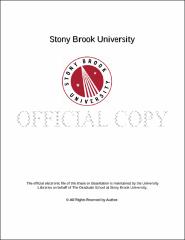| dc.identifier.uri | http://hdl.handle.net/11401/77669 | |
| dc.description.sponsorship | This work is sponsored by the Stony Brook University Graduate School in compliance with the requirements for completion of degree. | en_US |
| dc.format | Monograph | |
| dc.format.medium | Electronic Resource | en_US |
| dc.language.iso | en_US | |
| dc.publisher | The Graduate School, Stony Brook University: Stony Brook, NY. | |
| dc.type | Thesis | |
| dcterms.abstract | Thermal emission spectroscopy was used to determine the mineralogy of sandstone and mudstone rocks as part of an investigation of linear spectral mixing between sedimentary constituent phases. With widespread occurrences of sedimentary surfaces on Mars, the critical examination of sedimentary rocks spectral behavior provides a basis for interpreting the environment controlling the mineralogical history of this planet. Unmixing algorithms for thermal infrared rock spectra have previously proven to be a viable technique, with accuracies better than ~17 vol %. However, sedimentary rocks, with natural variation of composition, compaction, and grain size, have yet to be critically examined. In this work, we present an analysis of the thermal emission spectral (~270-1650 cm-1) characteristics of a suite of 12 sandstones and 15 mudstones, establishing a foundation for remote spectral studies of sedimentary surfaces. Results from this work are consistent with previous thermal emission spectroscopy studies and indicate that bulk rock mineral abundances can be estimated within 10 vol % for sandstones and within 20 vol % for mudstones, in comparison to traditionally used mineralogical techniques. During this investigation, X-ray diffraction, microRaman spectroscopy, and traditional point counting procedures were all evaluated in comparison with thermal emission spectroscopy and it was determined that each method contains its own intrinsic limitations. With thermal emission spectroscopy at the focal point of this work, it is concluded that derived mineralogy from spectral unmixing is an advantageous technique for mineral clasts; however, this technique remains highly ambiguous for the matrix (< 30 µm) fraction of sedimentary rocks. | |
| dcterms.abstract | Thermal emission spectroscopy was used to determine the mineralogy of sandstone and mudstone rocks as part of an investigation of linear spectral mixing between sedimentary constituent phases. With widespread occurrences of sedimentary surfaces on Mars, the critical examination of sedimentary rocks spectral behavior provides a basis for interpreting the environment controlling the mineralogical history of this planet. Unmixing algorithms for thermal infrared rock spectra have previously proven to be a viable technique, with accuracies better than ~17 vol %. However, sedimentary rocks, with natural variation of composition, compaction, and grain size, have yet to be critically examined. In this work, we present an analysis of the thermal emission spectral (~270-1650 cm-1) characteristics of a suite of 12 sandstones and 15 mudstones, establishing a foundation for remote spectral studies of sedimentary surfaces. Results from this work are consistent with previous thermal emission spectroscopy studies and indicate that bulk rock mineral abundances can be estimated within 10 vol % for sandstones and within 20 vol % for mudstones, in comparison to traditionally used mineralogical techniques. During this investigation, X-ray diffraction, microRaman spectroscopy, and traditional point counting procedures were all evaluated in comparison with thermal emission spectroscopy and it was determined that each method contains its own intrinsic limitations. With thermal emission spectroscopy at the focal point of this work, it is concluded that derived mineralogy from spectral unmixing is an advantageous technique for mineral clasts; however, this technique remains highly ambiguous for the matrix (< 30 µm) fraction of sedimentary rocks. | |
| dcterms.available | 2017-09-20T16:53:17Z | |
| dcterms.contributor | Glotch, Timothy | en_US |
| dcterms.contributor | Rogers, A.Deanne | en_US |
| dcterms.contributor | McLennan, Scott. | en_US |
| dcterms.creator | Thorpe, Michael Terrance | |
| dcterms.dateAccepted | 2017-09-20T16:53:17Z | |
| dcterms.dateSubmitted | 2017-09-20T16:53:17Z | |
| dcterms.description | Department of Geosciences. | en_US |
| dcterms.extent | 80 pg. | en_US |
| dcterms.format | Application/PDF | en_US |
| dcterms.format | Monograph | |
| dcterms.identifier | http://hdl.handle.net/11401/77669 | |
| dcterms.issued | 2014-12-01 | |
| dcterms.language | en_US | |
| dcterms.provenance | Made available in DSpace on 2017-09-20T16:53:17Z (GMT). No. of bitstreams: 1
Thorpe_grad.sunysb_0771M_12110.pdf: 153021747 bytes, checksum: 9d755a680435088a4ec55b3b93e6ae9c (MD5)
Previous issue date: 1 | en |
| dcterms.publisher | The Graduate School, Stony Brook University: Stony Brook, NY. | |
| dcterms.subject | MicroRaman Spectroscopy, Mineralogy, Mudstones, Sandstones, Thermal Emission Spectroscopy, X-ray diffraction | |
| dcterms.subject | Sedimentary geology | |
| dcterms.title | Thermal Emission Spectral Characterization of Sandstones and Mudstones | |
| dcterms.type | Thesis | |

